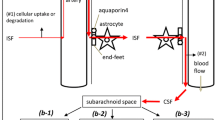Summary
The relationship between extravasation of protein into extracellular spaces of brain parenchyma and the water content of such regions were evaluated in an experimental model. In this model, a temporary opening of the blood-brain barrier (BBB) to proteins was produced without significant injury to the cellular elements of brain tissue. Rabbits were subjected to bolus injection of their own blood under 360–400 mm Hg pressure via the internal carotid artery. The opening of the barrier and its duration were evaluated with Evans blue (EB), horseradish peroxidase (HRP), and sodium fluorescein (NaFl) tracers. The water content of brain tissue was assessed by specific gravity (SG) measurements in 1-mm-diameter tissue samples. Quantitative evaluation of protein penetration into brain tissue was carried out using125I bovine serum albumin (BSA). The opening of the BBB to proteins persisted up to 9 h, whereas the barrier remained permeable to small molecular NaFl for 24 h. The SG measurements indicated in the areas of EB extravasation a progressive increment in water content up to 9 h, i.e., the duration of BBB opening to proteins. Following this, there was a progressive clearance of edema in spite of the BBB remaining open for NaFl for 24 h. Quantitative evaluations of125I-BSA and SG in the same tissue samples, supported by statistical analysis, indicated approximately linear relationship between albumin and water, implying a strong correlation between the development of vasogenic edema and extravasation of proteins into extracellular spaces.
Similar content being viewed by others
References
Bodsch W, Hurter T, Hossman K-A (1982) Immunochemical method for quantitative evaluation of vasogenic brain edema following cold injury of rat brain. Brain Res 249:111–121
Bosch W, Hossman K-A (1983) Relationship between and peptide fragments of albumin in cerebral edema. J Neurochem 41:239–243
Bothe H-W, Bodsch W, Hossman K-A (1984) Relationship between specific gravity, water content, and serum protein extravasation in various types of vasogenic brain edema. Acta Neuropathol (Berl) 64:37–42
Fujiwara K, Nitsch C, Suzuki R, Klatzo I (1981) Factors in reproducibility of the gravimetric method for evaluation of edematous changes in experimental cerebral edema. J Neuropathol Exp Neurol 41:113–128
Fujiwara K, Nitsch C, Suzuki R, Klatzo I (1981) Factors in reproducibility of the gravimetric method for evaluation of edematous changes in the brain. Neurol Res 3:345–361
Furuse M, Gonda T, Kuchiwaki H, Hirai N, Inao S, Kageyama N (1984) Thermal analysis on the state of free and bound water in normal and edematous brain. In: Go KG, Baethmann A (eds) Recent progress in the study and therapy of brain edema Plenum Press, New York London, pp 293–298
Gazendam J, Go KG, Van Zanten AK (1979) Composition of isolated edema fluid in cold-induced brain edema. J Neurosurg 51:70–77
Juhler M, Barry DI, Offner H, Konat G, Klinken L, Paulson OB (1984) Blood-brain and blood-spinal cord barrier permeability during the course of experimental allergic encephalitis in rat. Brain Res 302:347–355
Klatzo I, Chui E, Fujiwara K, Spatz M (1980) Resolution of vasogenic brain edema. In: Cervós-Navarro J, Ferszt R (eds) Brain edema. Advances in neurology, vol 28. Raven Press, New York, pp 359–374
Klatzo I, Suzuki R, Orzi F, Schuier F, Nitsch C (1984) Pathomechanism of ischemic brain edema. In: Go KG, Baethmann A (eds) Recent progress in the study and therapy of brain edema. Plenum Press, New York London, pp 1–10
Kuchiwaki H, Furuse M, Gonda T, Hirai N, Inao S, Ikeyama A, Kageyama N (1984) Studies on changes in tissue water constitution and focal brain tissue pressure in experimental cerebral infarction. In: Go KG, Baethmann A (eds) Recent progress in the study and therapy of brain edema. Plenum Press, New York London, pp 459–470
Marmarou A, Nakamura T, Tanaka T, Hochwald GM (1984) The time course and distribution of water in the resolution phase of infusion edema. In: Go KG, Baethmann A (eds) Recent progress in the study and therapy of brain edema. Plenum Press, New York London, pp 37–44
Marmarou A, Tanaka K, Schulman K (1982) The brain response to infusion edema: dynamics of fluid resolution. In: Hartmann A, Brock M (eds) Treatment of cerebral edema. Springer, Berlin Heidelberg New York, pp 11–18
Ohno K, Pettigrew KD, Rapoport SI (1978) Lower limits of cerebrovascular permeability to nonelectrolytes in the conscious rat. Am J Physiol 253:H299-H307
Patlak CS, Pettigrew KD (1976) A method to obtain infusion schedules for prescribed blood concentration time courses. J Appl Physiol 4:458–463
Rapoport SI (1976) Blood-brain barrier in physiology and medicine. Raven Press, New York, p 122
Rasmussen LR, Klatzo I (1969) Protein and enzyme changes in cold injury edema. Acta Neuropathol (Berl) 13:12–18
Steinwall O, Klatzo I (1966) Selective vulnerability of the blood-brain barrier in chemically induced lesions. J Neuropathol exp Neurol 25:542–559
Wagner H, Cahn R, Kuroiwa T, Ting P, Yamaguchi T, Klatzo I (1983) Role of the blood-brain barrier opening to proteins in the pathophysiology of cerebral ischemia. J Cereb Blood Flow Metab [Suppl 1] 3:S417-S418
Author information
Authors and Affiliations
Rights and permissions
About this article
Cite this article
Kuroiwa, T., Cahn, R., Juhler, M. et al. Role of extracellular proteins in the dynamics of vasogenic brain edema. Acta Neuropathol 66, 3–11 (1985). https://doi.org/10.1007/BF00698288
Received:
Accepted:
Issue Date:
DOI: https://doi.org/10.1007/BF00698288




